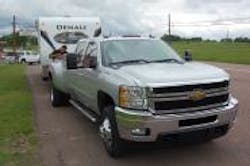“In the end, all that matters is the customer’s perception.” – Brent Deep, development engineer for full size heavy-duty pickups at General Motors
Brent Deep is pretty unusual for a truck engineer. For starters, he’s six-foot-six, which means he often must fold himself up like a pretzel to fit into the cabs of the trucks he test drives for a living.
Then there’s Deep’s job title. He’s dubbed a “development engineer” now because that’s what he’s supposed to do – to develop the heavy-duty pickups built by General Motors so they perform above and beyond customer expectations.
[Here’s a unique computer generated imagery or CGI look at the underpinnings of GM’s new 2011 Chevy Silverado 3500 HD pickup.]
In the past, though, his job bore the ungainly title of “powertrain integration engineer,” because that’s what most of the work focused on – getting the engine, transmission and axles to work together as a single, integrated unit.
But the work is different now because it’s not all about numbers and outputs anymore, he told me. Oh, for sure, matching transmission shift points to the engine’s torque curve remains just as critical, as do about a billion other algorithmic calculations managing every other aspect of vehicle operation, such as fuel consumption, engine braking, stability control, etc.
Yet Deep (standing behind the pickup in the photo below at right) told me a lot of what he does revolves around a most unlikely engineering characteristic: "feeling."
“How transmission shifting 'feels' to the driver, how the vehicle behaves on different road surfaces, these are the kinds of things drivers and owners notice before anything else,” he explained.
“You might have a truck with great fuel economy or really fast zero-to-60 acceleration speed. But if the customer doesn’t like how the truck changes gears, or if the engine braking comes on too soon, or if they hear annoying sounds, then they aren’t going to buy your truck,” Deep said.
So his job is to go out and drive these trucks for hundreds – if not thousands – of miles on regular roads, as well as on test tracks, recording myriads of data on truck performance, but also searching for those subtle “feelings” resulting from vehicle operation.
“For example, I felt that on steep grades, engine braking should activate sooner; that it should react faster to steeper downhill descent,” Deep told me. “So the engineers reprogrammed everything and I tried it out. But then I found it just came on too soon – it annoyed me, for lack of a better word. It interfered with my judgment as a driver. So we set it back the way it was.”
[Here’s a short clip about how GM’s new 2011 Chevy Silverado pickups get built.]
Smooth shifting is another factor Deep spent a lot of time working on, trying to get things “just so” to make the driver experience that much cleaner as well as more efficient. “In some cases, we went to short shifts to better match the torque curve without disturbing the drive experience,” he said.
Then there’s “pedal travel,” which encompasses vehicle acceleration response. “We feel you should get to use ‘the whole pedal’ when accelerating,” Deep explained. “You should get a different level of acceleration at every stage of the pedal. You shouldn’t get full response when you ‘tip in’ to 25% pedal depression, with acceleration rate unchanged as the pedal goes all the way to the floor.”
That full range of “pedal travel, Deep added, also helps the driver better manage their fuel economy. “By having that full range of pedal travel, you can better manage how much fuel you’re consuming,” he said. “It gives you, the driver, more control.”
The toughest part about Deep’s job, though, is that if he does everything right, if nails both “feelings” as well as the algorithms … then the customer should never notice.
He’s constantly tweaking things to make driving on of GM’s pickup trucks as uneventful as possible, with no untoward hitches or shimmies, bumps or noises, working behind the scenes and hoping to stay that way.
It’s just one of the many unseen engineering disciplines that keeps making trucks better and better, now and for the future.
